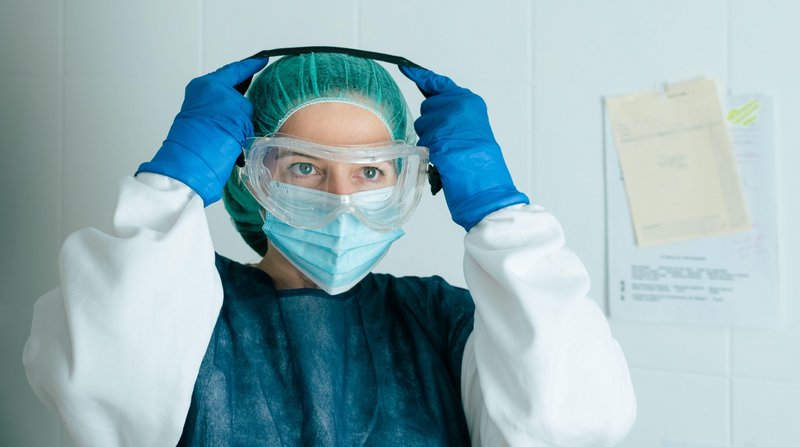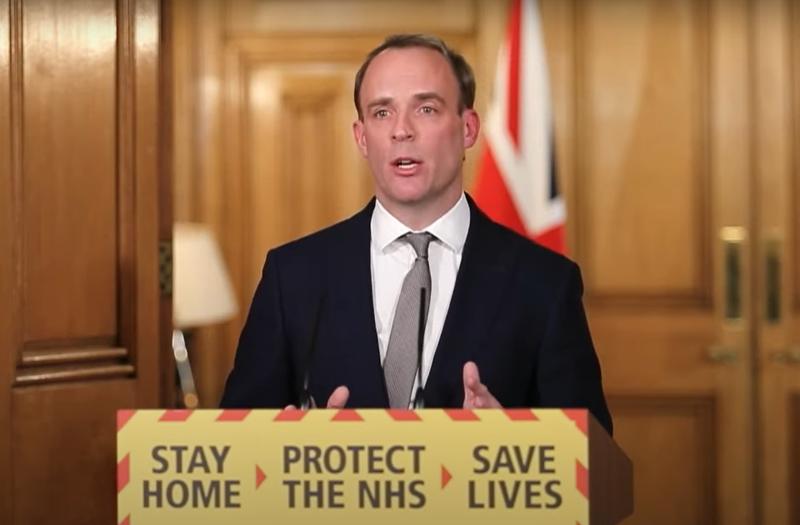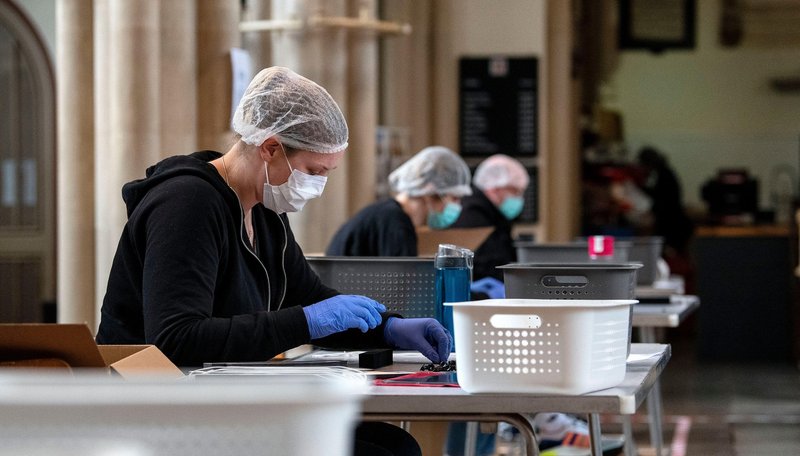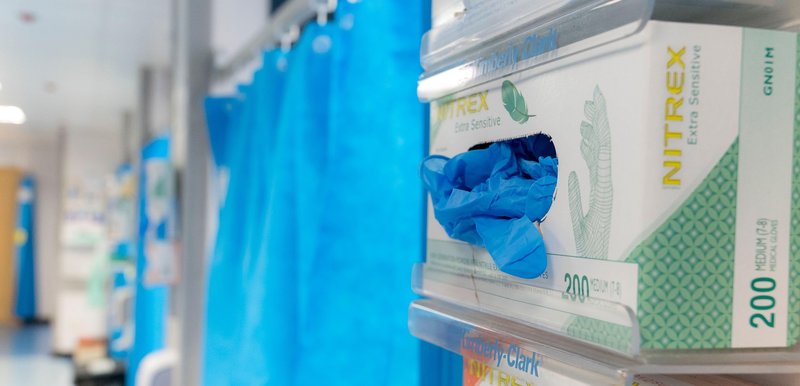PPE: What actually happened during the first wave?

On 16 April, Foreign Secretary Dominic Raab announced at the daily coronavirus briefing the five tests that needed to be met before the government would consider easing the first national lockdown.
To consider adjusting the current measures, the Foreign Secretary said the government would look at whether:
- The NHS had the ability to provide sufficient critical care across the UK
- Death rates were falling
- Infection rates were falling to manageable levels
- Testing capacity and PPE would meet future demand
- Proposed adjustments would not risk a second peak of infections
Some of these things were relatively simple to measure and communicate, particularly death rates and infection rates.
However with PPE, the government never really answered the question of whether we had enough, let alone if we would have enough to meet future demand.
The number of new contracts with PPE suppliers, and how many billion items of PPE had been supplied (whether or not that figure included counting gloves individually) were held up as some form of evidence for easing restrictions through the spring and early summer.
But none of this really answered the question because, crucially, the figures meant little without the context of how much PPE was needed.
Against this backdrop, the media was full of stories about specific shortages, as people tried to piece together what was actually happening.
On 20 April, the BBC reported that the amount of PPE distributed was unlikely to be enough to meet demand, though it noted “there are no national figures being supplied on [demand] so far.”
On 27 April, an episode of Panorama carried testimony from various doctors, blaming the government for shortages in their trusts. These claims were subsequently challenged by those who claimed the medical professionals were politically motivated.
The concern about PPE grew so great that problems with individual shipments of PPE were front page news.
For months, Full Fact was asked again and again by readers whether the NHS had enough PPE, a question we couldn’t answer sufficiently at the time.
So we decided to ask all the trusts across the UK how much PPE they had and how much they were using throughout March and April.
This data can’t answer every question. For one thing, we know that PPE was needed beyond the NHS, and there is evidence that social care providers in particular received far less than they needed.
However, with data obtained through Freedom of Information requests from 106 NHS hospital trusts across the UK, we can try and shed a bit more light on the question.
Most trusts appear to have had supplies of respirators, face masks, aprons and gloves during March and April, though there were some apparent isolated shortages. The supply of gowns, especially the highest protection gowns, was more limited.
However the data on PPE supply, which was meant to inform how stock was distributed around the country, was only widely available well into the first wave; where it was available, it was not utilised until May; and even then had clear problems regarding quality and detail.

Join 72,547 people who trust us to check the facts
Subscribe to get weekly updates on politics, immigration, health and more.
Changing systems
Prior to the pandemic, trusts bought PPE directly from suppliers, but also from NHS Supply Chain, a centralised procurement facility.
But faced with both increased PPE demand from healthcare systems across the world in response to the pandemic, and reduced supply, the existing supply chain struggled to cope
In response the Department of Health and Social Care set up the “Parallel Supply Chain”.
Instead of trusts raising orders from the supply chain, as they would for non-PPE products, PPE was bought centrally, and trusts would be sent, or “pushed”, an amount of PPE that was also determined centrally. They could also try and procure what they could directly from suppliers, though this was, to some extent, discouraged to avoid any detriment caused by trusts competing against each other on the open market for scarce supplies.
Trusts were also encouraged to share and donate stocks to each other to bridge need— what’s called “mutual aid.” To help with this, the Supply Chain made available a report showing the volume of PPE delivered to each trust in England and Wales by day.
In theory, the new system allowed scarce resources to be coordinated to make sure that all trusts had enough supply.
However, in practice, the system required the central operation to know what was happening on the ground in different trusts. It needed to know how much stock trusts had, how much they were using, and how close they were to running out.
But when the Parallel Supply Chain was set up, none of this was routinely available from the data gathered.

Slow data
In a report into PPE supply during the spring and summer, the National Audit Office (NAO) wrote: “Initially the [parallel PPE supply chain] did not have information about what PPE was held by trusts.”
This is also borne out by the data, or rather lack of it, submitted by trusts to us covering the period in early March.
Of the 106 trusts which provided data to us, only one was routinely recording PPE stocks in its central stores from the beginning of March, and that was a mental health trust, so not even directly involved in the treatment of Covid-19 patients. Well into April, many trusts were still not recording their daily position on PPE, and even fewer recording how many days’ stock they had left.
This lack of data led to some fairly crude methods of allocating PPE. To start with, trusts simply received the same amount of PPE from the supply chain irrespective of need.
But the NAO says “the Parallel Supply Chain developed, and continually refined, a process to determine where it distributed PPE.” It adds that the Department of Health and Social Care then began to assess the need for PPE and estimating how much would be needed for a 90 day period. A model “considered more reliable” was then in place from mid-April.
Additionally, there was “a daily engagement process” incorporating feedback from NHS regions and trusts.
From 4 May, “NHS England & NHS Improvement[…]was able to collect data from English trusts about the PPE they held, and it used this to refine the Department’s requirement model and inform decisions about which PPE should be delivered to which trusts in England.”
This is surprising because, while most trusts were not recording data on PPE stock at the beginning of March, many were recording this data considerably before 4 May, and submitting that data to NHS Improvement through daily “situation reports.”
NHS Improvement told us it did eventually receive data on PPE stocks from every trust in England. (We have requested a copy of this information, and will update this piece if we receive it.)
When we asked DHSC why it only started to use this data from 4 May to inform its approach it told us: “The Government took multiple steps to understand the scale of demand, increase supply and expand distribution of PPE from the earliest stages of the pandemic, including liaising daily with NHS Trusts on PPE to inform stock provision.”
Regardless, even once the supply chain had data from hospitals, there is evidence that the data was not comprehensive, meaning its usefulness was limited.

We might have some out the front
On 23 March, Oxford Health Foundation Trust, a non-acute trust providing community-based physical, mental health and social care, received 4,800 FFP3 respirators from the supply chain.
The next day it received a further 3,900 and the day after, on 25 March, it received 2,240.
This was completely sufficient. The trust told us it was using just 200 FFP3 respirators per day, meaning these deliveries would stock the trust for almost two months.
However, despite these deliveries, on 25 March the trust’s own data indicated it had no FFP3 respirators at all.
When we asked Oxford Health Foundation Trust why those deliveries don’t show up in its stock take, it told us: “Initial deliveries went straight to the teams and across various sites and those deliveries weren’t accounted for by the central PPE team data collection.”
Similarly on 9 April, East Cheshire Trust, which does operate a general district hospital providing acute care, indicated it had 8,200 aprons remaining, despite needing 10,000 per day.
But data from the supply chain shows it had pushed 71,000 aprons to the trust on 6 April and 75,000 on 8 April. So where had they all gone?
East Cheshire Trust told us: “The trust changed the method of stock management and stock issue week commencing the 13/4/20. Apron/glove stock management was moved to improve the accuracy of our stock data.”
Various trusts told us that low stock levels in their data did not mean they ran out or had a shortage as it didn’t capture everything they actually had.
It makes sense that trusts couldn’t collect comprehensive data about PPE stock levels when PPE had to be located across a trust’s many sites.
But that raises a question as to how the supply chain was meant to interpret the situation as it was using this data to make decisions about where to send PPE.
Did a trust with low stock levels really have a need for more PPE or were they actually fine?
Now this data wasn’t the only thing determining whether trusts received PPE deliveries or not. As mentioned, the expected need for PPE had also been modelled.
Trusts could also flag up specific issues in a text box on their data report, and were asked to indicate roughly how many days’ stock of each item they had left, though it’s unclear how this was assessed by all trusts, given many told us they didn’t have data on the amount they were using each day.
And, if the push deliveries were not adequate, and trusts could not source PPE from other trusts via mutual aid, trusts were able to call on the “National Supply Distribution Response” service for emergency supplies.
That aside, it’s clear that the data coming in from trusts rarely represented the total stock trusts actually had.

Gowns
Another issue apparent from the data we received from trusts concerned gowns, which saw some of the most severe national shortages during the spring.
There were a few reasons for this. On top of general issues with supply and demand, gowns ran short, in part, because PHE’s PPE stockpile—which was intended to deal with an influenza outbreak—did not contain gowns.
Also, at the time, only one UK company, Don & Low in Scotland, had the capability to produce approved fluid-repellent material used to make the highest-grade gowns.
On 17 April Public Health England had issued advice to trusts to reserve these fluid-repellent gowns for high risk areas where “aerosol generating procedures” were taking place and to use less protective gowns or aprons elsewhere in order to preserve stocks.
On 21 April, Chris Hopson, the chief executive of NHS Providers, the body which represents NHS trusts in England, wrote in The Times that, for trust leaders: “It is extremely worrying that staff who need long-sleeved gowns, in line with formal PPE guidance from Public Health England, cannot access them because of national supply shortages.”
He added: “Some trusts have reached the point where they cannot provide gowns to all staff who need them in line with existing national guidance. This can rightly be described as “running out” of gowns,” but also said trusts may still have other types of gowns.
It’s clear then that some types of gowns recommended for specific tasks were running shorter than other types. But it was unclear how trusts could communicate that in the data to NHS Improvement.
Kettering General Hospital Trust told us: “The sitrep information we were submitting, as required from [NHS England/Improvement], did not differentiate between different types of gowns.” Similarly, the supply chain’s reports on deliveries suffered from the same problem.
Even the general category of “gowns” may not have been clearly defined. Kettering’s data, for instance, showed almost 35,000 gowns being procured across late April and early May, apparently far exceeding the stock at most other trusts.
However when we asked the trust where these came from it said they were “generally long-sleeve thumb loop gowns”, which are also referred to as aprons and may have been categorised as such by other trusts.

Shortages?
All these issues, along with the fact that only 106 trusts provided data to us makes drawing firm conclusions on the severity of shortages over the spring difficult. This included 90 of the 217 trusts in England, 3 of the 6 boards in Northern Ireland, 5 of the 7 boards in Wales and 8 of the 14 boards in Scotland.
Nevertheless it does help tell part of the story.
Most trusts which submitted their data in response to our FOI, and recorded their usage levels, maintained at least five days’ worth of stock for FFP3 respirators, surgical masks, aprons and gloves for most of the period covered by their data between 5 March and 5 May 2020.
This doesn’t necessarily mean there were not “shortages”, either in the sense of stock running low or trusts rationing stock. This should be understood within the context of many health and care workers reporting not having access to PPE, even if it was held by trusts, and testimony from those workers of a chaotic state of affairs in trying to get hold of enough PPE.
Also this is putting aside any quality issues with PPE stocks of which there were, reportedly, many.
However, for gowns far more trusts operated with less than five days’ stock in central stores for significant periods of time.
While few appeared to run out completely, this may reflect the fact that, as mentioned, trusts tended to record stocks of all gowns together and so may have had more severe shortages of high-grade surgical gowns, and we know that the national guidance was to, essentially, ration gowns.
Data we collected also indicated shortages of solution used to fit FFP3 respirators, as reported at the time. If the wearer can taste the solution when it is sprayed at them, that’s a sign that there is a gap in the seal as (if worn properly) the respirator should filter out these particles.
During the first wave, the increased demand for FFP3 respirators meant trusts relied on models that differed from their usual supply, meaning wearers had to be “fit tested” again and more solution was needed.
While Full Fact did not ask trusts for information on the amount of solution they held, some nevertheless provided this data which backs up these reports.
For example, University Hospitals of North Midlands Trust had no solution from when it started collecting data on PPE stocks on 16 April to 30 April. Hampshire Hospitals Foundation Trust had none from 21 April to at least 5 May (the final date we asked for data on). The Isle of Wight Trust showed that no solution was delivered to hospital wards or departments for the entire duration of the period covered by its data (from 13 April 31 May).
The shortage led to some trusts (though not necessarily those named above) pausing fit-testing, potentially increasing the risk of staff being exposed to SARS-CoV-2.
There was also some indication of localised shortages though it is hard to be certain, given the issues mentioned.
For example, the acute Sherwood Forest Hospitals Trust in Nottinghamshire submitted data showing an apparent depletion of surgical masks. NHS Providers note that: “At different times during the months from March to May, IIR [surgical] masks were also in short supply.”
On 14 April, the trust said it held 2,000 masks centrally against a daily need of 9,000. Despite a delivery of 8,000 from the supply chain on 16 April, by 19 and 20 April, the trust had none in stock at all.
However Sherwood Forest Hospitals’ apparent shortage happened during a period when there seemed to be stock elsewhere in the system.
An hour away in Wakefield, the South West Yorkshire Partnership Trust, which does not provide acute care, had over 110,000, enough to keep the trust going for, by its own count, 26 days.
When asked for comment, Sherwood Forest Hospitals Trust said it “has been well supplied with PPE throughout the pandemic with good mutual aid from partners.”
Unanswered questions
While it is hard to be definitive about the level of PPE shortages during the first wave, what’s more certain is the shortcomings in the data infrastructure.
In evidence to MPs NHS Providers wrote: “The lack of available data around national stock levels of PPE, coupled with the unpredictable nature of push deliveries and their contents, made it extremely difficult for trust leaders to plan ahead and deliver services.”
Ultimately, the data infrastructure which helped the supply chain understand the national PPE supply picture was set up well into the first wave, rather than being part of business-as-usual for trusts.
And even once data began to come in, there were problems with comprehensiveness and accuracy meaning that central authorities did not have timely accurate information about the true PPE supply levels.
Of course not all insight and knowledge is captured in the data, and we appreciate that trust leaders and the supply chain were also in conversation about need.
However, it is not unreasonable to suggest that issues with data quality may have affected the efficiency with which PPE was distributed around the country, especially in those early weeks.
This piece set out to answer whether there was enough PPE in the NHS during the first wave. While the data we received provided some indications of particular pressures, it is unfortunately not comprehensive enough to draw firm conclusions from.
But what we can say with more confidence is that the fact that we don’t have the evidence to draw such a conclusion, due to issues with the data, is itself a problem.